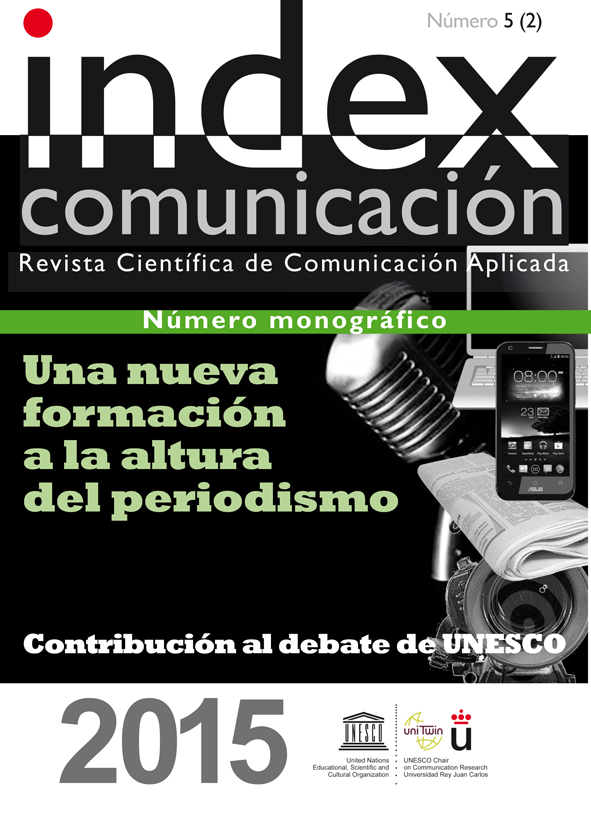Media literacy education in the CV of journalists
Keywords:
comunicación audiovisual, enseñanza, educomunicación, alfabetización, Education, Communication, Curriculum, Media Literacy, Media Competence, JournalismAbstract
The aim of this article is to present some of the findings of the research: Media Competence. The diagnosis of the three contexts: the professional one, the university level, and the compulsory educational level”. Since 2011, the research groups have worked in this project with more than 50 researchers of 18 spanish universities. In previous works, the antecedents of Media Literacy have been studied collecting the contributions of several authors of media education. For more than five decades, a good deal of researchers have investigated the wide context of educommunication in Europe and Latin America. The traditional context of Literacy has been an inspiration to include other lenguages like the audiovisual media ones. First, the concept of media literacy won the battle but nowadays hypermedia, multimedia and transmedia, have taken over.Metrics
References
Aguaded, J. I. et al. (2011): ‘El grado de competencia mediática en la ciudadanía andaluza’. Memoria de investigación. Huelva: Grupo Comunicar, Universidad de Huelva, Grupo Ágora.
Aparici, R. (Ed.). (2010): Educomunicación: más allá del 2.0. Barcelona: Gedisa.
Arnanz, C.; García, E. y Lara, T. (2010): La industria audiovisual en España. Escenarios de un futuro digital. Madrid: MEC, Academia TV y EOI.
Buckingham, D. (2013): La infancia materialista. Crecer en la cultura consumista. Madrid: Morata.
Buitrago, A.; Navarro, E. y García Matilla, A. (2015, en prensa): ‘Communication, education and society in a digital context. A pioneering experience of media literacy at the Spanish university’, en Media Literacy: experiences in Brazil, Portugal and Spain. Goteborg: Nordicom, International Clearinghouse on Children and Media.
Castells, M. (2006): La sociedad red. Madrid: Alianza editorial.
Comisión Europea (Ed.) (2009): Recomendación de la Comisión, de 20 de agosto de 2009, sobre la alfabetización mediática en el entorno digital para una industria audiovisual y de contenidos más competitiva y una sociedad del conocimiento incluyente. [Diario Oficial L 227 de 29.8.2009] (05-02-11).
Comunicar (2012). Revista Científica Iberoamericana de Comunicación y Educación. 38. xix. Alfabetización mediática en contextos múltiples. Huelva. Grupo Comunicar.
Echazarreta, C. (2014): ‘El paradigma de la digital literacy’. Gerona, ICOM. UAB. Consultado el 14 de diciembre de 2014 desde: http://portalcomunicacion. com/lecciones_det.asp?id=76
FAPE (2014): Informe anual de la profesión periodística. Madrid: FAPE.
Ferrés, J. (2014): Las pantallas y el cerebro emocional. Barcelona: Gedisa.
Ferrés, J.; García Matilla, A.; Aguaded, I.; Fernández Cavia, J.; Figueras, M.; y Blanes, M. (2011): Competencia Mediática. Investigación sobre el grado de competencia de la ciudadanía en España. Madrid: MEC (ITE) y CAC.
García Matilla, A. (2003): Una televisión para la Educación. La utopía posible. Barcelona: Gedisa.
García Matilla, A. (2010): ‘Publicitar la Educomunicación en la Universidad del siglo xxi’, en Aparici, R. (Ed.): Educomunicación: más allá del 2.0. Barcelona: Gedisa. pp. 151-168.
Grandío, M.; Vicente, M.; García, A.; Gutiérrez, A.; y Marta, C. (2014): ‘Media and Information Literacy Policies in Spain. In Evaluation of Media and Information Literacy Policies in Spain’, en Translit and Cost “Transforming Audiences/Transforming Societies”. París: Unesco. Consultado el 28 de diciembre de 2014 desde: http://ppemi.ens-cachan.fr/data/media/colloque140528/ra pports/SPAIN_2014.pdf
Johnson, S. (2012): Future perfect. The case for Progress in a Networked Age. New York: Penguin Goup.
Kapuscinski, R. (2005): Los cinco sentidos del periodista. Madrid: Asociación de la Prensa de Cádiz, Asociación de la Prensa de Madrid, Fondo de Cultura Económica.
Kovach, B. y Rosenstiel, T. (2001): The elements of journalism. New York: Random House.
Marta, C.; Grandío, M.; y Gabelas, J. A. (2013): ‘La Educación mediática en las titulaciones de Educación y Comunicación de las universidades españolas. Análisis de los recursos recomendados en las guías docentes’, en Vivat Academia. Consultado el 29 de diciembre de 2’14 desde: http://www.vivatacad emia.net/index.php/vivat/article/view/554/7
Mattelart, A. (2014): Por una mirada-mundo. Barcelona: Gedisa.
Orozco, G. (2014): Televidencias. Comunicación, Educación y ciudadanía. Guadalajara (México): Universidad de Guadalajara.
Pérez, M. A. y Delgado, A. (2012): ‘From Digital and Audiovisual Competence to media Competence. Dimensions and indicators’ (‘De la competencia digital y audiovisual a la competencia mediática: dimensiones e indicadores’), en Comunicar nª 39, V. xx, p. 25-33.
Pérez Tornero, J. M. y Martínez Cerdá, J. F. (2011): ‘Hacia un sistema supranacional de indicadores mediáticos’, en Infoamérica, 5, p. 39-57. En línea desde: www.infoamerica.org/icr/icr_05.htm
Retis, J.; Lamuedra, M.; y García, A. (2010): Los informativos diarios en BBC y TVE. Madrid: De la Torre.
Rincón, O. (Ed.). (2013): Zapping TV. El paisaje de la tele latina. Bogotá: FES.
Squirra, S. (Org.) (2012): Cibermídias. Extensoes comunicativas, expansoes humanas. Porto Alegre: Buqui.
Tucho, F.; Masanet, M. y Blanco, S. (2014): ‘La cuestión medioambiental en la Educación mediática: un reto pendiente’, en Zer, revista de estudios de Comunicación, nº 36, pp. 205-219.
Vizer, E. (2006): La trama in(visible) de la vida social. Comunicación, sentido y realidad. Buenos Aires: La Crujía.
Downloads
Published
How to Cite
Issue
Section
License
Authors who submit to this journal agree to the following terms:
Authors retain copyright and ensure the magazine's right to be the first publication of the work as licensed under a Creative Commons Attribution-NoComercial 4.0 International License that allows others to share the work with an acknowledgment of authorship of the work and the initial publication in this magazine, with no commercial purpose.
Authors can establish separate additional agreements for non-exclusive distribution of the version of the work published in the magazine (for example, to an institutional repository or publish it in a book), with an acknowledgment of its initial publication in this journal.
It allows and authors are encouraged to disseminate their work electronically (eg, in institutional repositories or on their own website) prior to and during the submission process, as it can lead to productive exchanges, as well as a citation more early and most of the published work (See The Effect of Open Access).















